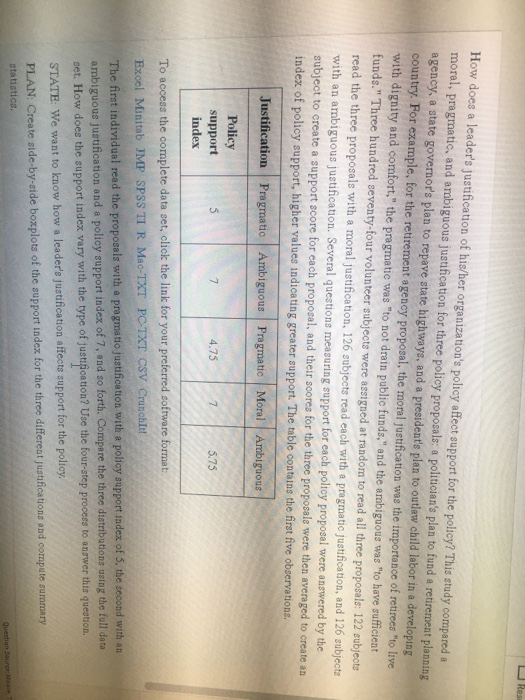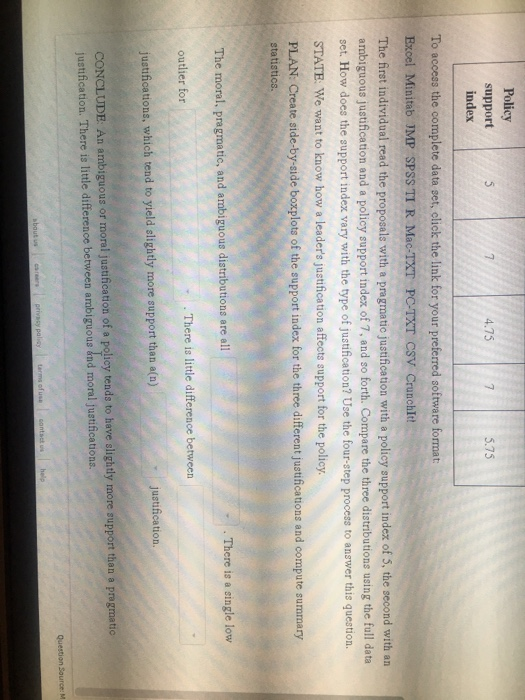How does a leader's justification of his/her organization's policy affect support for the policy? This study compared a moral, pragmatic, and ambiguous justification for three policy proposals: a politician's plan to fund a retirement planning agency, a state governor's plan to repave state highways, and a president's plan to outlaw child labor in a developing country. For example, for the retirement agency proposal, the moral justification was the importance of retirees "to live with dignity and comfort," the pragmatic was "to not drain public funds," and the ambiguous was "to have sufficient funds." Three hundred seventy-four volunteer subjects were assigned at random to read all three proposals: 122 subjects read the three proposals with a moral justification, 126 subjects read each with a pragmatic justification, and 126 subject with an ambiguous justification. Several questions measuring support for each poltcy proposal were anzwered by the subject to create a support score for each proposal, and their scores for the three prop index of policy support, higher values indicating greater support, The table contains the first five observations. osals were then avera ged to create an Justification Pragmatio Ambiguous Pragmatic Moral Ambiguous Policy support index 4.75 5.75 To access the complete data set, click the link for your preferred software format: Excel Minitab JMP SPSS TI R Mac-TXT PC-TXT CSV Crunchlt The first individual read the proposals with a pragmatic justification with a policy support index of 5, the second with an ambiguous justification and a policy support index of 7, and so forth. Compare the three distributions using the full data aet. How does the support index vary with the type of justifioation? Use the four-step process to anower this question. STATE We want to know how a leader's justification affects support for the poltey PLAN. Create aide-by-side boxplots of the aupport index for the three differeat justfications and compute eummary etatistics. Policy support index 4.75 75.75 To access the complete data set, click the link for your preferred software format Excel Minitab JMP SPSS TI R Mac-TXT PCTXT CSV CrunchIt The first individual read the proposals with a pragmatio justification with a policy support index of 5, the second with an ambiguous justification and a policy support index of 7, and so forth. Compare the three distributions using the full data set. How does the support index vary with the type of justification? Use the four-step process to answer this question. STATE We want to know how a leader's justification affects support for the policy. PLAN: Create side-by-side boxplots of the support index for the three different justifications and compute summary statistics. . There is a single low The moral, pragmatic, and ambiguous distributions are all outlier for - There is little difference between justification. justiications, which tend to yield elightly more support than a() CONCLUDE An ambiguous or moral justification of a policy tends to have slightly more support thana justification. There is little difference between ambiguous and moral justifications. Question Source: M How does a leader's justification of his/her organization's policy affect support for the policy? This study compared a moral, pragmatic, and ambiguous justification for three policy proposals: a politician's plan to fund a retirement planning agency, a state governor's plan to repave state highways, and a president's plan to outlaw child labor in a developing country. For example, for the retirement agency proposal, the moral justification was the importance of retirees "to live with dignity and comfort," the pragmatic was "to not drain public funds," and the ambiguous was "to have sufficient funds." Three hundred seventy-four volunteer subjects were assigned at random to read all three proposals: 122 subjects read the three proposals with a moral justification, 126 subjects read each with a pragmatic justification, and 126 subject with an ambiguous justification. Several questions measuring support for each poltcy proposal were anzwered by the subject to create a support score for each proposal, and their scores for the three prop index of policy support, higher values indicating greater support, The table contains the first five observations. osals were then avera ged to create an Justification Pragmatio Ambiguous Pragmatic Moral Ambiguous Policy support index 4.75 5.75 To access the complete data set, click the link for your preferred software format: Excel Minitab JMP SPSS TI R Mac-TXT PC-TXT CSV Crunchlt The first individual read the proposals with a pragmatic justification with a policy support index of 5, the second with an ambiguous justification and a policy support index of 7, and so forth. Compare the three distributions using the full data aet. How does the support index vary with the type of justifioation? Use the four-step process to anower this question. STATE We want to know how a leader's justification affects support for the poltey PLAN. Create aide-by-side boxplots of the aupport index for the three differeat justfications and compute eummary etatistics. Policy support index 4.75 75.75 To access the complete data set, click the link for your preferred software format Excel Minitab JMP SPSS TI R Mac-TXT PCTXT CSV CrunchIt The first individual read the proposals with a pragmatio justification with a policy support index of 5, the second with an ambiguous justification and a policy support index of 7, and so forth. Compare the three distributions using the full data set. How does the support index vary with the type of justification? Use the four-step process to answer this question. STATE We want to know how a leader's justification affects support for the policy. PLAN: Create side-by-side boxplots of the support index for the three different justifications and compute summary statistics. . There is a single low The moral, pragmatic, and ambiguous distributions are all outlier for - There is little difference between justification. justiications, which tend to yield elightly more support than a() CONCLUDE An ambiguous or moral justification of a policy tends to have slightly more support thana justification. There is little difference between ambiguous and moral justifications. Question Source: M








